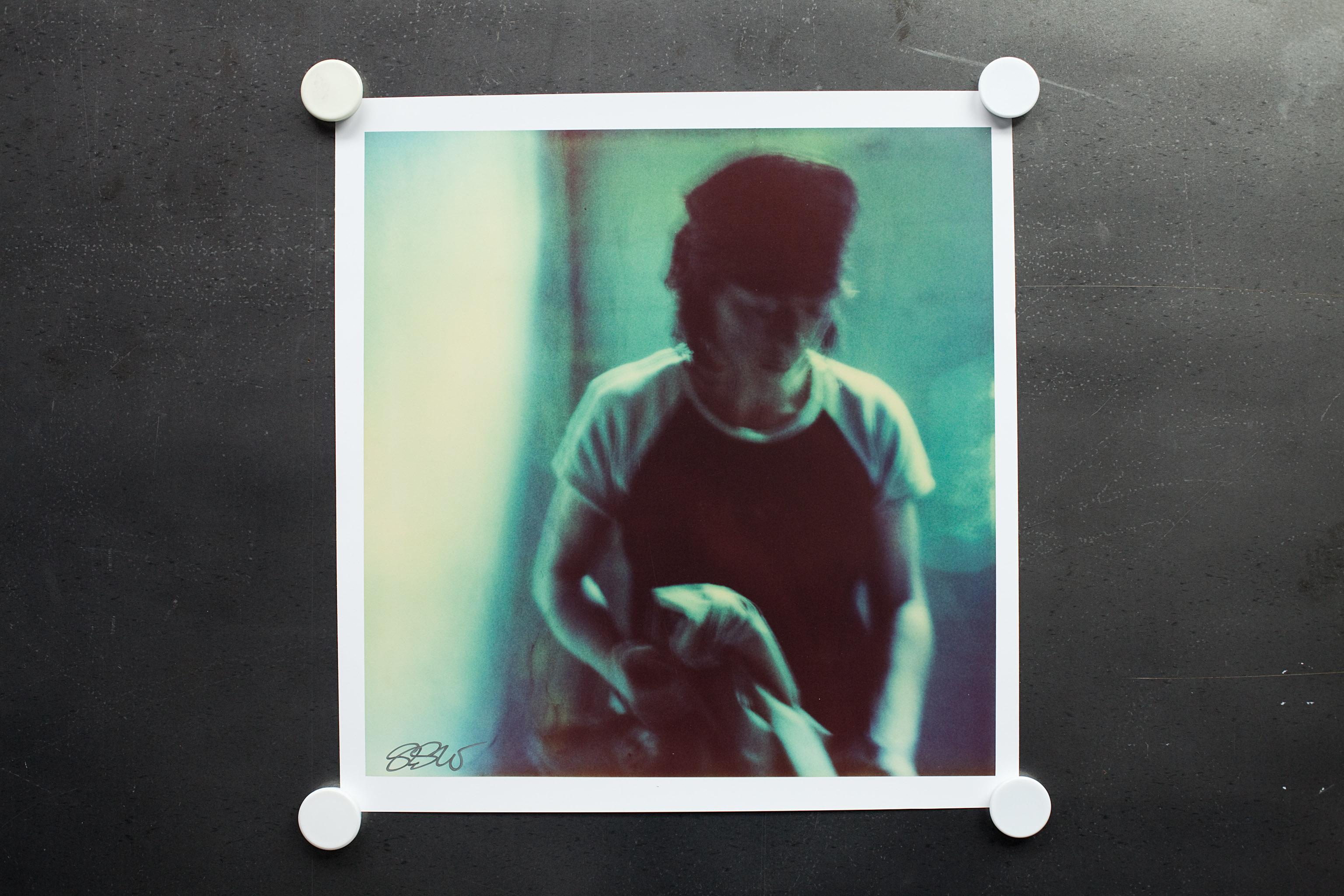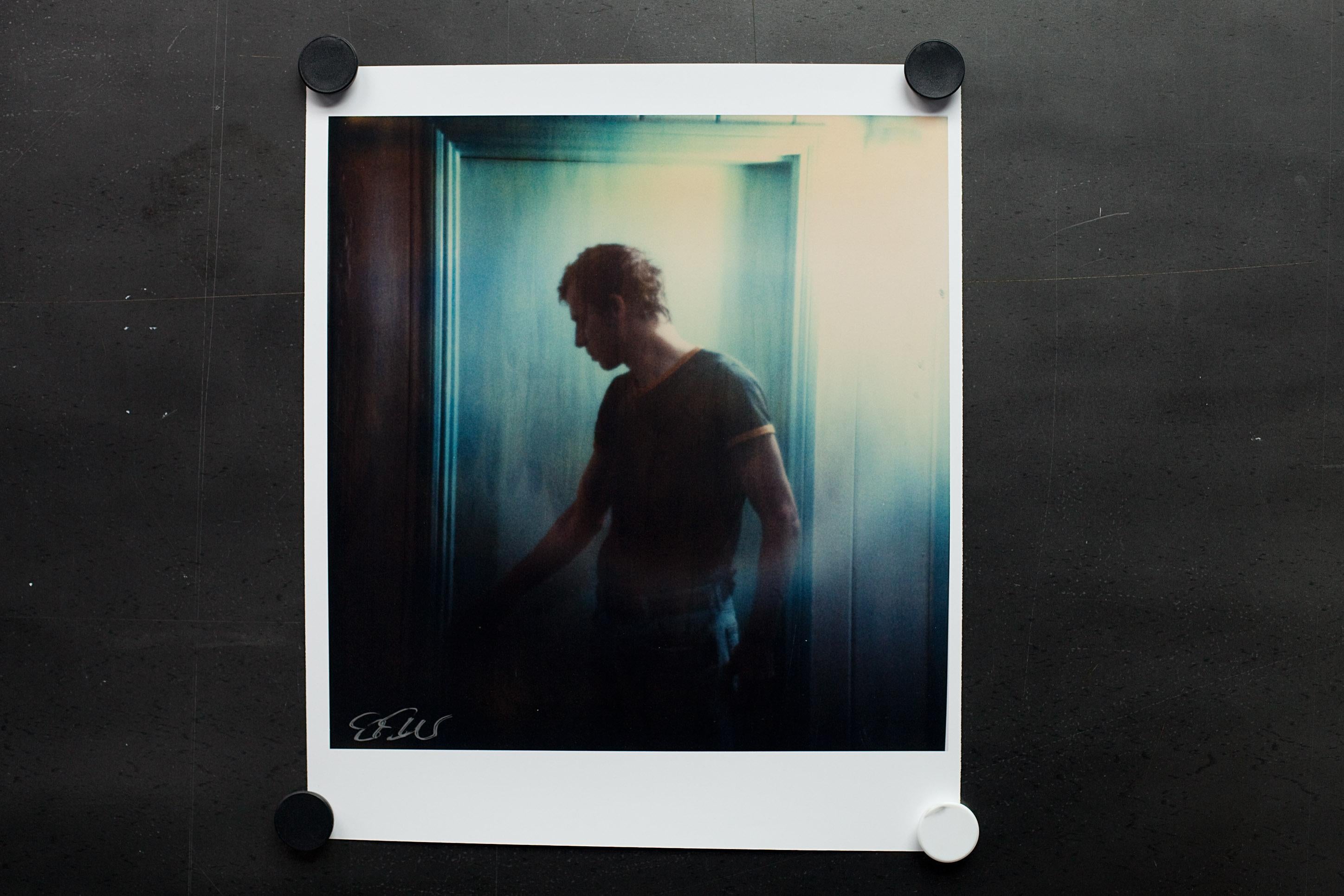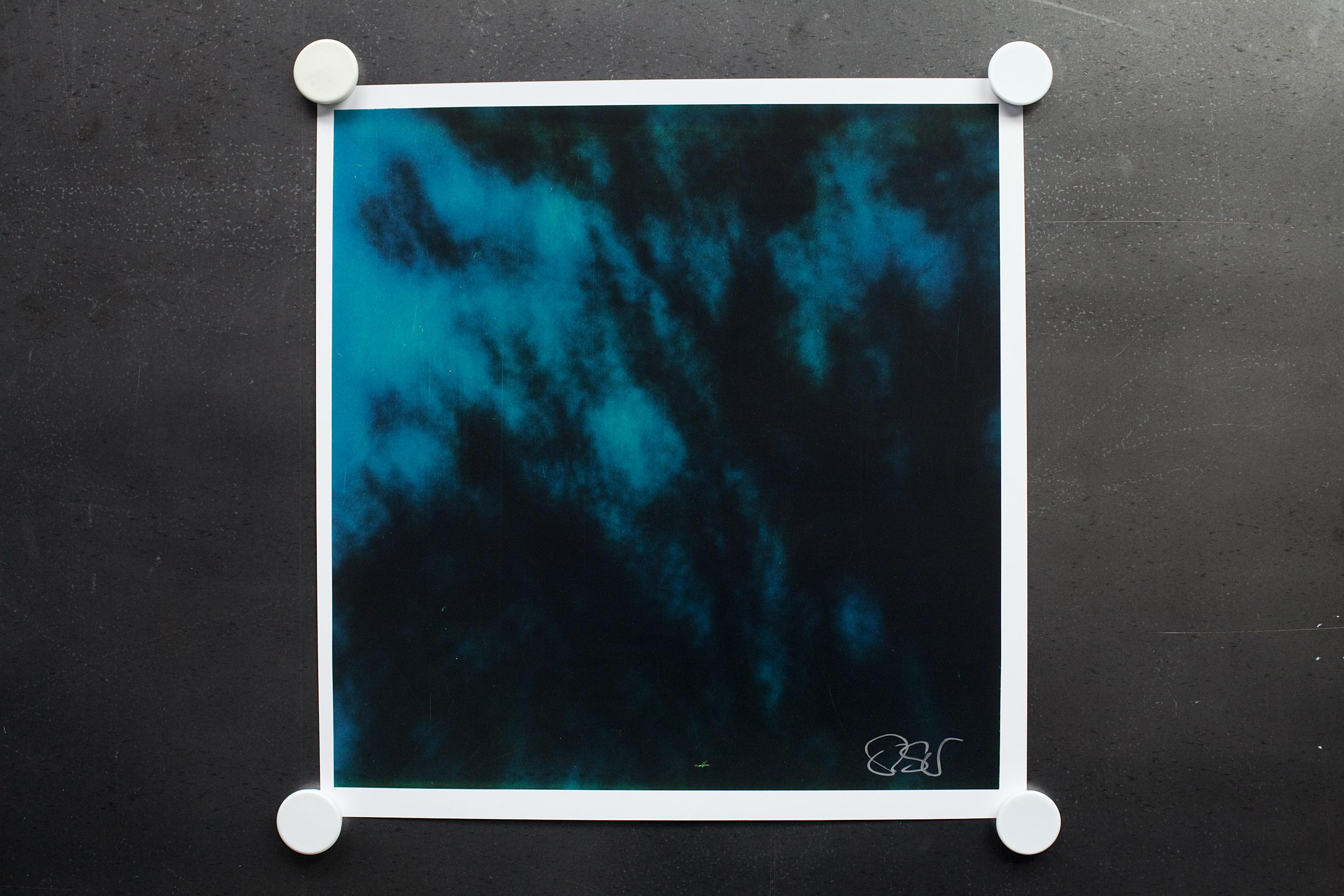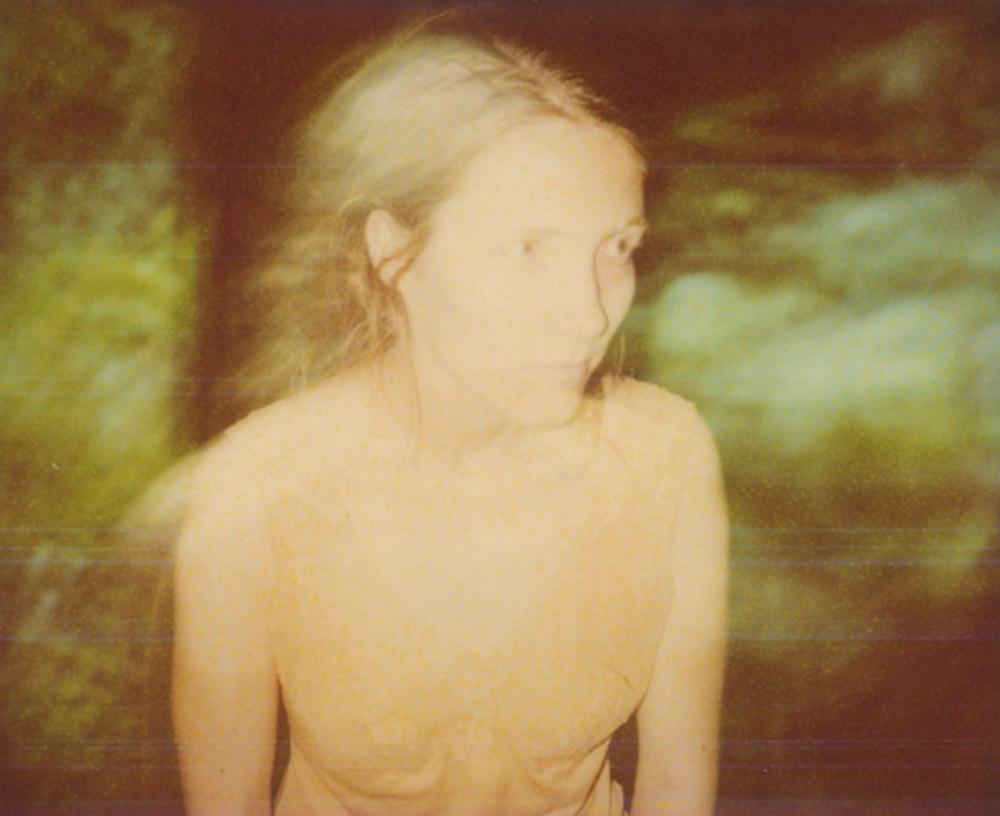Objekte ähnlich wie Shotgun Hochzeit (Haley und die Vögel) - Zeitgenössisch, figürlich, Polaroid, Mädchen
Möchten Sie mehr Bilder oder Videos?
Zusätzliche Bilder oder Videos von dem*der Anbieter*in anfordern
1 von 5
Stefanie SchneiderShotgun Hochzeit (Haley und die Vögel) - Zeitgenössisch, figürlich, Polaroid, Mädchen2013
2013
Angaben zum Objekt
Shotgun Wedding (Haley and the Birds) - 2013
28x38cm,
Auflage von 10 Stück.
Archival C-Print, based on a Polaroid.
Artist Inventory No. 17607.
Not mounted.
Stefanie Schneider interviewed by Instantdreams movie.
When did you first decide to work with Polaroids? Why do Polaroids seem to be so well tuned to our (artistic) senses, perception and minds?
I started using expired Polaroid film in 1996 but I've been developing my own photographic work since 1984. Polaroid has the most beautiful quality and encapsulates my vision perfectly. The colors on one hand, but then the magic moment of witnessing the image appear. Time seems to stand still, and the act of watching the image develop can be shared with the people around you. It captures a moment, which becomes the past so instantly that the decay of time is even more apparent; – it gives the image a certain sentimentality. The Polaroid moment is an original every time.
Why use a medium from the past?
For me, analog has always been there in the present. For the new generation, analog is interesting because it's new to them. I understand that people growing up in a digital age will wonder about its usefulness, but it's theirs to recover if they want to. When I first started working with Polaroid, it wasn't the past. It was a partially forgotten medium, but it existed nonetheless. It is mine by choice. There is no substitute for tangible beauty.
Is it imperfect?
The imperfect perfection in a “wabi-sabi” kind of way.
Wabi-sabi (侘寂) represents a comprehensive Japanese world view or aesthetic centered on the acceptance of transience and imperfection. The aesthetic is sometimes described as one of beauty that is imperfect, impermanent, and incomplete.
If an object or expression can bring about, within us, a sense of serene melancholy and a spiritual longing, then that object could be said to be wabi-sabi. Wabi-sabi nurtures all that is authentic by acknowledging three simple realities: nothing lasts, nothing is finished, and nothing is perfect.
Is the Polaroid photograph recognizable or even sometimes cliché?
Absolutely! There's something cliché about the way I'm showing the American Dream. I live it myself, trying to find perfection in an imperfect world. Reaching for the horizon. The dream is broken; the cliché tumbles. There are different ways to involve an audience. You could make movies like Harmony Korine's 'Gummo', a masterpiece in my view, which would estrange a large part of the audience. A certain film education is a prerequisite. Or you can start with clichés, the audience then feels safe, which lures them into the depth of your world without them even knowing it or understanding where exactly they are being led to. Appealing to emotions and the sub-conscious. Normal, Change, New Normal.
You continually revisit the landscape of the American West in your work. What draws you back to this scene?
Southern California represents a dream to me. The contrast of Northern Germany, where I grew up, to the endless sunshine of Los Angeles was what first attracted me. The American West is my dream of choice. Wide, open spaces give perspectives that articulate emotions and desires. Isolation feeds feelings of freedom or sometimes the pondering of your past. The High Desert of 29 Palms has very clear and vivid light, which is vital. Expired Polaroid film produces 'imperfections' that I would argue mirrors the decline of the American dream. These so called 'imperfections' illustrate the reality of that dream turning into a nightmare. The disintegration of Western society.
Are you playing with the temporality of the material and the value of the moment itself?
The value of the moment is paramount, for it is that moment that you're trying to transform. All material is temporary, it's relative, and time is forever.
Why does analog film feel more pure and intuitive?
It's tangible and bright and represents a single moment.
The digital moment may stay in the box (the hard drive / camera / computer etc.) forever, never to be touched, put into a photo album, sent in a letter, or hung on a wall. Printing makes it an accomplishment.
The analog world is more selective, creating images of our collective memory.
The digital worldwide clicking destroys this moment. The generation without memories due to information overload and hard drive failures. Photo albums are a thing of the past.
Why does it feel this way?
That's how the human instinct works.
When I was a child, every picture been taken was a special moment. Analog photographic film as well as Super-8 material were expensive treasures. My family's memories were created by choosing certain moments in time. There was an effort behind the picture. The roll of film might wait months inside the camera before it was all used. From there, the film required developing, which took more time, and finally, when the photos were picked up from the shop, the memories were visited again together as a family. Who knew then, how fleeting these times were. Shared memories was a ritual.
What's your philosophy behind the art of Polaroid pictures?
The 'obsolete' is anything but obsolete. Things are not always as they appear, and there are hidden messages. Our memories and our dreams are under-valued. It is there that real learning and understanding begins by opening yourself to different perspectives.
What inspired you to use stop motion cinematography?
My work has always resembled movie stills. I remember the first time I brought a box of Polaroids and slid them onto Susanne Vielmetter's desk (my first gallery). Instantly, it became apparent that there was a story to tell. The stories grew. It was undeniable to me, that the emerging story was where I was destined to go. I've made four short films before my latest feature film, "The Girl behind the White Picket Fence". This film is 60 minutes long with over 4000 edited Polaroids. It's important to remember that our sub-conscious fills in the blanks, the parts missing from the story allow a deeper and more personal experience for the viewer. That is, if you surrender yourself and trust me as the director to lead you somewhere you might not have been before.
Why do you think it is important to own art?
Nietzsche said "We have art in order not to die of the truth."
Nietzsche
- Schöpfer*in:Stefanie Schneider (1968, Deutsch)
- Entstehungsjahr:2013
- Maße:Höhe: 28 cm (11,03 in)Breite: 38 cm (14,97 in)Tiefe: 1 mm (0,04 in)
- Medium:
- Bewegung und Stil:
- Zeitalter:
- Zustand:
- Galeriestandort:Morongo Valley, CA
- Referenznummer:1stDibs: LU65239474682
Stefanie Schneider
Stefanie Schneider erhielt ihren MFA in Kommunikationsdesign an der Folkwang Schule Essen, Deutschland. Ihre Arbeiten wurden u.a. im Museum für Fotografie, Braunschweig, Museum für Kommunikation, Berlin, dem Institut für Neue Medien, Frankfurt, dem Nassauischen Kunstverein, Wiesbaden, Kunstverein Bielefeld, Museum für Moderne Kunst Passau, Les Rencontres d'Arles, Foto -Triennale Esslingen, Bombay Beach Biennale 2018, 2019 gezeigt.
Informationen zu dem*der Anbieter*in
4,9
Platin-Anbieter*in
Diese von Expert*innen geprüften Anbieter*innen sind die erfahrensten Anbieter*innen von 1stDibs und werden von unseren Kund*innen am besten bewertet.
Gründungsjahr 1996
1stDibs-Anbieter*in seit 2017
955 Verkäufe auf 1stDibs
Typische Antwortzeit: 4 Stunde
- VersandAngebot wird abgerufen …Versand von: Morongo Valley, CA
- RückgabebedingungenDie Rückgabe dieses Objekts kann innerhalb von 7 Tagen ab Lieferung veranlasst werden.
Einige Inhalte dieser Seite wurden automatisch übersetzt. Daher kann 1stDibs nicht die Richtigkeit der Übersetzungen garantieren. Englisch ist die Standardsprache dieser Website.
Mehr von diesem*dieser Anbieter*inAlle anzeigen
- Max Blau (Die letzte Bilderausstellung) - based on a Polaroid Original – ProofVon Stefanie SchneiderMax Blue (The last Picture Show) Proof b4 Druck, 38x36cm, 2005 analoger C-Print, von der Künstlerin handgedruckt, basierend auf einem Polaroid, signiert auf der Vorderseite. Dies i...Kategorie
1990er, Zeitgenössisch, Farbfotografie
MaterialienFotopapier, Archivpapier, C-Print, Polaroid, Farbe
- Bates Motel I (Die letzte Bilderausstellung) – based on a Polaroid Original – ProofVon Stefanie SchneiderBates Motel I (Letzte Filmvorführung) Proof b4 Druck, 38x36cm, 2005 analoger C-Print, von der Künstlerin handgedruckt, basierend auf einem Polaroid, signiert auf der Vorderseite. D...Kategorie
1990er, Zeitgenössisch, Farbfotografie
MaterialienFotopapier, Archivpapier, C-Print, Farbe, Polaroid
- Tree at Night (Die letzte Bilderausstellung) – based on a Polaroid Original – ProofVon Stefanie SchneiderBaum bei Nacht (Last Picture Show) Proof b4 Druck, 38x36cm, 2005 analoger C-Print, von der Künstlerin handgedruckt, basierend auf einem Polaroid, signiert auf der Vorderseite. Dies...Kategorie
1990er, Zeitgenössisch, Farbfotografie
MaterialienFotopapier, Archivpapier, C-Print, Farbe, Polaroid
- Untitled (Fairytales) - analog, Contemporary, Polaroid, FarbeVon Stefanie SchneiderUnbetitelt (Märchen) - 2006 48x59cm, Auflage 3/5. Analoger C-Print, von der Künstlerin handgedruckt auf Fuji Crystal Archive Papier, matt, nach dem Original Polaroid. Etikett mi...Kategorie
Anfang der 2000er, Zeitgenössisch, Farbfotografie
MaterialienFotopapier, C-Print, Farbe, Polaroid, Archivpapier
- Lila & Sam – Zeitgenössisch, figürlich, Polaroid, Fotografie, ausgestellt, AnalogVon Stefanie SchneiderEin Kunstwerk aus dem Kinofilm "Stay" von Stefanie Schneider Stefanie hat das Design für die beiden Hauptdarsteller Naomi Watts und Ryan Gosling in dem Film 'Stay' unter der Regie v...Kategorie
Anfang der 2000er, Zeitgenössisch, Farbfotografie
MaterialienFotopapier, Archivpapier, C-Print, Polaroid, Farbe
- Circle of Magic - A Wish - 29 Palms, CA, analog, montiertVon Stefanie SchneiderEin Wunsch" (Circle of Magic) aus dem Projekt 29 Palms, CA, 2009, 37x47cm, Auflage 5/5, analoger C-Print, handgedruckt von der Künstlerin auf Fuji Crystal Archive Papier, basierend ...Kategorie
Anfang der 2000er, Zeitgenössisch, Farbfotografie
MaterialienFotopapier, Archivpapier, C-Print, Polaroid, Farbe
Das könnte Ihnen auch gefallen
- Terry O'Neill – Faye Dunaway am Pool, Fotografie 1977Von Terry O'NeillDie amerikanische Schauspielerin Dorothy Faye Dunaway war in den 1970er Jahren eine der angesagtesten Schauspielerinnen, die neurotische, getriebene Frauen mit Sex-Appeal spielte. Sie arbeitete auf der Bühne, bevor sie auf die Leinwand wechselte und die Hauptrolle in dem bahnbrechenden Film Bonnie und Clyde (1967) spielte, für den sie eine Oscar-Nominierung erhielt. Im Laufe ihrer Karriere wirkte sie in mehreren legendären Filmen mit, darunter The Thomas Crown Affair...Kategorie
1970er, Zeitgenössisch, Farbfotografie
MaterialienArchivpapier, Fotopapier, C-Print
- Tyler Shields - Pille, Fotografie 2020Von Tyler ShieldsSerie: Mündungen Chromogener Druck auf Kodak Endura Luster Papier Alle verfügbaren Größen und Ausgaben: 18" x 18" 30" x 30" 40" x 40" 60" x 60" 70" x 70" Ausgaben von 3 + 2 Artist Pr...Kategorie
2010er, Zeitgenössisch, Farbfotografie
MaterialienLüster, Archivpapier, Fotopapier, C-Print
- Tyler Shields - The Girl with The Red Glove, Fotografie 2021, gedruckt nachVon Tyler ShieldsReihe: Historische Belletristik Chromogener Druck auf Kodak Endura Luster Papier Alle verfügbaren Größen und Ausgaben: 15" x 20" 22.5" x 30" 30" x 40" 45" x 60" 56" x 72" 63" x 84" A...Kategorie
2010er, Zeitgenössisch, Farbfotografie
MaterialienDigitalpigment, Lüster, Archivalisches Pigment, Tintenstrahl, Laser, Dig...
- Tyler Shields - The Girl in The Red Car, Fotografie 2021, gedruckt nachVon Tyler ShieldsReihe: Historische Belletristik Chromogener Druck auf Kodak Endura Luster Papier Alle verfügbaren Größen und Ausgaben: 15" x 20" 22.5" x 30" 30" x 40" 45" x 60" 56" x 72" 63" x 84" A...Kategorie
2010er, Zeitgenössisch, Farbfotografie
MaterialienLüster, Papier, Archivtinte, Archivpapier, Fotopapier, C-Print, Farbe, D...
- Isabelle Van Zeijl - Higher Love, Fotografie 2020, NachdruckVon Isabelle Van ZeijlHöhere Liebe C-Print auf Fuji-Papier Collection'S: FLOWER LOVE Einheitsgröße: 40,5 x 40,5 Auflage von 8 Stück + 2 Probedrucke BLUMENLIEBE Rosen erwärmen das Herz, sie inspirieren un...Kategorie
2010er, Zeitgenössisch, Farbfotografie
MaterialienArchivtinte, Archivpapier, Fotopapier, C-Print, Digital, Archivalisches ...
- Isabelle Van Zeijl - Ihre Roots, Fotografie 2020, gedruckt nachVon Isabelle Van ZeijlIhre Wurzeln klein C Druck auf Fuji-Papier Collection'S: Flower Evolution Einheitsgröße: 38,5 x 60 Auflage von 6 + 2 Artist Proofs, 7 übrig "EVOLUTION DER BLUMEN Die zarte und anm...Kategorie
2010er, Zeitgenössisch, Farbfotografie
MaterialienArchivtinte, Digitalpigment, Archivalisches Pigment, Digital, C-Print, F...





